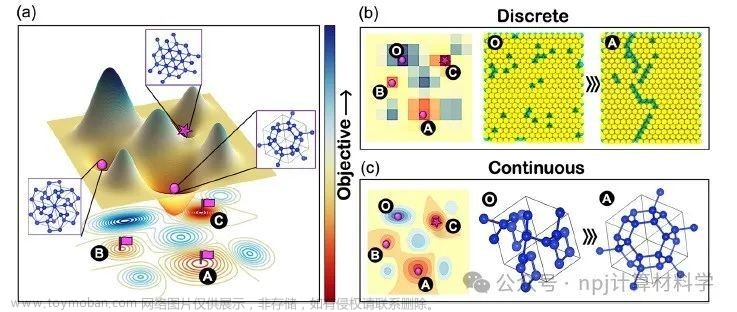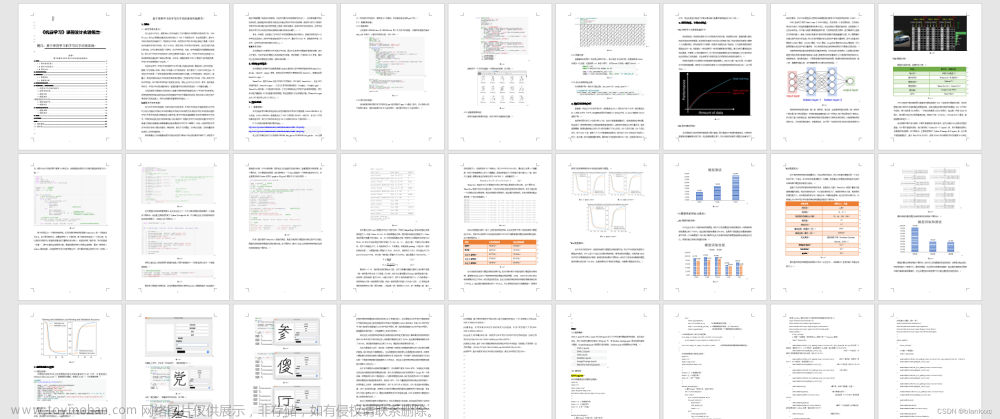高效的晶体结构预测(CSP)是材料科学中的一项重要挑战,其涉及在复杂的构型空间中寻找亚稳态晶体多形体的结构–性质关系。随着AI和机器学习技术的应用,特别是强化学习(RL),在高维搜索空间中的优化过程得以提升效率和准确性,推动了材料设计和发现的新范式。这些方法不仅加速了全局最优解的发现,还有助于探索和利用局部最小值,为材料创新提供更广阔的可能性。

Fig. 1 Schematic illustration of the nature of the search space (discrete vs. continuous) in materials applications.
阿贡国家实验室纳米材料中心的Subramanian K. R. S. Sankaranarayanan教授及其团队开发的CASTING,是一个针对高维搜索空间内约束满足问题(CSP)的工作流程,它采用了基于连续动作空间树的强化学习(RL)搜索算法。

Fig. 2 MCTS working as crystal structure optimizer.
该研究团队对蒙特卡洛树搜索(MCTS)算法进行了关键的算法改进,使其能够成功地应用于与结构和拓扑预测相关的连续搜索空间逆问题。

Fig. 3 Schematic depicting the workflow of the CASTING framework for performing inverse design.
通过对CASTING框架的效能进行展示,此项工作将该技术应用于各种代表性系统,包括单一成分的金属系统如银(Ag)和金(Au)、共价系统如碳(C)、二元系统如氮化硼(h-BN)和碳氢化合物(C-H),以及多组分钙钛矿系统如掺杂的镍铌氧化物(NNO)。

Fig. 4 Exploring the performance and scalability of CASTING framework using an example metal polymorph.
此外,研究还采用了多目标优化策略,对超硬碳相进行逆向设计。研究显示,CASTING在处理复杂材料科学问题上显示出良好的扩展性、采样准确度以及快速的收敛能力。

Fig. 5 Effect of tree hyperparameter on the sampling, convergence, and solution quality of Ag polymorphs.
同时,还对不同的强化学习超参数如何影响搜索性能进行了深入探讨。CASTING也被用于在不同维度系统中采样稳定和亚稳态的多态性,涵盖从三维(块体)到低维系统如零维(团簇)和二维(片层)。

Fig. 6 Comparison of structure prediction for carbon polymorphs with an empirical potential model.
与其他元启发式搜索算法进行比较时,如遗传算法、盆地跳跃和随机抽样,MCTS在解决方案的质量和收敛速度方面显示出了明显的优势。这项技术被认为特别适合于解决那些具有多重目标、多种组分和多维度的复杂搜索问题。

Fig. 7 Structural diversity of sampled Carbon(C) polymorphs using CASTING.
整体上,该研究成功地证明了强化学习技术如MCTS在结构和拓扑预测的逆向材料设计和发现问题中的应用潜力。该文近期发表于npj Computational Materials 9: 177 (2023).

Fig. 8 Convergence with size-dependent diversity in nanoclusters of Gold (Au).
Editorial Summary
To reverse design of materials? Please ask the AIEfficient crystal structure prediction (CSP) is a key challenge in materials science, which involves finding structure-property relationships for substable crystalline polymorphs in a complex configuration space. With the application of AI and machine learning techniques, especially reinforcement learning (RL), the optimization process in high-dimensional search spaces has been able to improve efficiency and accuracy, driving a new paradigm in materials design and discovery. These methods not only accelerate the discovery of globally optimal solutions, but also help to explore and utilize local minima, providing broader possibilities for materials innovation. 
Fig. 9 Exploring 2D polymorphs with CASTING.
A team lead by Prof. Subramanian K. R. S. Sankaranarayanan from Center for Nanoscale Materials, Argonne National Laboratory, introduced CASTING which is a workflow that implements a continuous action space tree-based RL search algorithm for CSP in a high-dimensional search space. 
Fig. 10 Comparison of the performance of CASTING with commonly used optimizers in crystal structure prediction.
The authors discuss the important algorithmic modifications that are needed in the MCTS to successfully apply it to continuous search space inverse problems associated with structure and topology predictions. To showcase the efficacy of the CASTING framework, the authors apply CASTING to a wide range of representative systems—single-component metallic systems such as Ag and Au, covalent systems such as C, binary systems such as h-BN and C-H, and multicomponent perovskite systems such as doped NNO.

Fig. 11 Exploration of the configurational space of hydrogen doped Neodymium Nickel Oxide (NNO) with CASTING framework.
Additionally, the authors perform the inverse design of super-hard carbon phases using multi-objective optimization. The authors demonstrate the scalability, accuracy of sampling, and speed of convergence of CASTING on complex material science problems. The authors discuss the impact of the various RL hyperparameters on search performance. CASTING is also deployed to sample stable and metastable polymorphs across systems with dimensionality ranging from 3D (bulk) to low dimensional systems such as 0D (clusters) and 2D (sheets). Comparisons to other metaheuristic search algorithms such as genetic algorithms, basin hopping, and random sampling are also shown—the MCTS is demonstrated to have a superior performance in terms of the solution quality and the speed of convergence.

Fig. 12 Inverse design of super hard phases of Carbon (C).
The authors expect MCTS to perform well, especially for complex search landscape with multiple objectives, multiple species, and multi-dimensional systems. Overall, the authors successfully demonstrate the development and application of an RL techniques such as MCTS for inverse materials design and discovery problems related to structure and topology predictions. This article was recently published in npj Computational Materials 9: 177 (2023).
原文Abstract及其翻译
A Continuous Action Space Tree search for INverse desiGn (CASTING) framework for materials discovery(连续动作空间树搜索用于材料发现的逆向设计(CASTING)框架)
Suvo Banik, Troy Loefller, Sukriti Manna, Henry Chan, Srilok Srinivasan, Pierre Darancet, Alexander Hexemer & Subramanian K. R. S. Sankaranarayanan
Abstract
Material properties share an intrinsic relationship with their structural attributes, making inverse design approaches crucial for discovering new materials with desired functionalities. Reinforcement Learning (RL) approaches are emerging as powerful inverse design tools, often functioning in discrete action spaces. This constrains their application in materials design problems, which involve continuous search spaces. Here, we introduce an RL-based framework CASTING (Continuous Action Space Tree Search for inverse design), that employs a decision tree-based Monte Carlo Tree Search (MCTS) algorithm with continuous space adaptation through modified policies and sampling. Using representative examples like Silver (Ag) for metals, Carbon (C) for covalent systems, and multicomponent systems such as graphane, boron nitride, and complex correlated oxides, we showcase its accuracy, convergence speed, and scalability in materials discovery and design. Furthermore, with the inverse design of super-hard Carbon phases, we demonstrate CASTING’s utility in discovering metastable phases tailored to user-defined target properties and preferences.
摘要文章来源:https://www.toymoban.com/news/detail-833566.html
材料的性能与其结构特征息息相关,这种关联性促使逆向设计成为寻找具备特定功能新材料的关键手段。最近,强化学习(RL)方法作为逆向设计的强有力工具慢慢崭露头角,通常这些方法在离散的动作空间内发挥作用。然而,这种做法限制了它们在材料设计中的应用,因为这通常涉及到连续的搜索空间。在此,我们介绍一个基于RL的新框架——CASTING(连续动作空间树搜索逆向设计),它采用了一种基于决策树的蒙特卡洛树搜索(MCTS)算法,并且经过策略调整和采样改良,使其适应连续空间。我们通过一系列代表性案例,如金属中的银(Ag)、共价体系中的碳(C)、以及复合材料系统,例如石墨烯、氮化硼和复杂的相关氧化物,来展现CASTING框架在材料发现和设计中的高准确度、快速收敛性和良好的扩展性。此外,通过针对超硬碳相材料的逆向设计实例,我们证明了CASTING在探索符合用户指定目标性能和偏好的亚稳态材料方面的实用价值和有效性。文章来源地址https://www.toymoban.com/news/detail-833566.html
到了这里,关于想做材料逆向设计?问问人工智能吧的文章就介绍完了。如果您还想了解更多内容,请在右上角搜索TOY模板网以前的文章或继续浏览下面的相关文章,希望大家以后多多支持TOY模板网!










